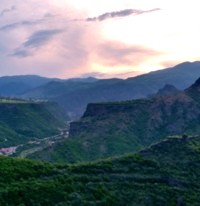The Armenian Genocide Museum
The Armenian Genocide Museum is about three kilometres north-west of the city on an historic hill where there was once an iron-age fort.
It was built in Soviet times in response to a demand from Armenians in 1965 when one hundred thousand people demonstrated in Yerevan for 24 hours to remember the 50th anniversary of the 1915 Genocide, perpetrated by the Ottomans (Turkey) and to insist that it be officially recognised by the Soviet Union.
In response this memorial was designed and completed in November 1967. In addition to the subterranean museum there is a 44-meter stele symbolising the national rebirth of Armenians. Twelve slabs are positioned in a circle, representing the twelve lost provinces in present-day Turkey. In the centre of the circle, at a depth of 1.5 meters, there is an eternal flame dedicated to the 1.5 million people killed during the Armenian Genocide.
Approaching the museum from the car park there are groves of trees and long line of individual trees planted by numerous world leaders in remembrance. It's very touching. The museum itself is harrowing. It's mostly photographic and pictures of dead and mutilated bodies abound.
Although the events of 1915 are central to its construction the story of the oppression of the Armenian people is a lot older. As I've already noted (above) Lord Byron was already appalled by this and trying to help in 1876.
The trouble goes back even further to an agreement between the Persians and the Ottomans to cede Western Armenia to Turkey. Christians in Western Armenia were allowed a level of self-management but the province was impoverished. This resulted an Armenian diaspora, when Christian Armenians migrated to other places in the Ottoman Empire and elsewhere, particularly to Istanbul.
Yet as a migrant minority they became increasingly despised as infidels and were denied civil rights; often forced into slavery; or their girls stolen and forced to convert to be taken and tattooed as Islamic wives or servants.
With Russia's victory in the Russian Turkish war in 1878 the Armenian Question, that Byron had raised, began to concern the Christian Powers of Europe, who together demanded reform in Turkey.
In response Sultan Abdul Hamid II decided than rather than grant Armenians full civil rights it was easier to eliminate them. Groups of Turkish irregulars were assembled and granted the right to deal with the Armenians 'as they wished'. The resulting unpunished massacres continued from 1894 to 1896.
But the real trouble began under the Young Turks, who decided that 'the salvation of the Turkish Homeland' required the elimination from Turkey of all non-Muslim elements, Christians and Jews alike and towns, including those in Turkish Western Armenia, with a non-Muslim majority were put to the sword. One and a half million were slaughtered. Turkey persists in denying these events, so one function of the museum is, as Auschwitz is for that more famous genocide, to provide documentary evidence of the atrocities to the world.
This is a long and complex history so I refer you to Wikipedia. Read more...
Sultan Abdul Hamid II dripping with blood. The massacres of 1894 - 1896 were followed by the mass slaughter of 1915
The two attempted genocides are not unrelated. That student of history, Adolph Hitler, would later use the Armenian Massacre to reassure his troops that what they were about to do would later be admired. In a speech to Wehrmacht commanders at his Obersalzberg home on 22 August 1939, a week before they invaded Poland he would declare:
Unsere Stärke ist unsere Schnelligkeit und unsere Brutalität. Dschingis Khan hat Millionen Frauen und Kinder in den Tod gejagt, bewußt und fröhlichen Herzens. Die Geschichte sieht in ihm nur den großen Staatengründer. Was die schwache westeuropäische Zivilisation über mich behauptet, ist gleichgültig. Ich habe den Befehl gegeben – und ich lasse jeden füsilieren, der auch nur ein Wort der Kritik äußert – daß das Kriegsziel nicht im Erreichen von bestimmten Linien, sondern in der physischen Vernichtung des Gegners besteht. So habe ich, einstweilen nur im Osten, meine Totenkopfverbände bereitgestellt mit dem Befehl, unbarmherzig und mitleidslos Mann, Weib und Kind polnischer Abstammung und Sprache in den Tod zu schicken. Nur so gewinnen wir den Lebensraum, den wir brauchen. Wer redet heute noch von der Vernichtung der Armenier?
Our strength consists in our speed and in our brutality. Genghis Khan led millions of women and children to slaughter – with premeditation and a happy heart. History sees in him solely the founder of a state. It's a matter of indifference to me what a weak western European civilization will say about me. I have issued the command – and I'll have anybody who utters but one word of criticism executed by a firing squad – that our war aim does not consist in reaching certain lines, but in the physical destruction of the enemy. Accordingly, I have placed my death-head formation in readiness – for the present only in the East – with orders to them to send to death mercilessly and without compassion, men, women, and children of Polish derivation and language. Only thus shall we gain the living space (Lebensraum) which we need. Who, after all, speaks today of the annihilation of the Armenians?

